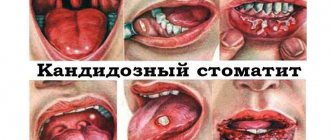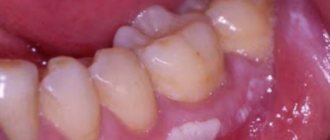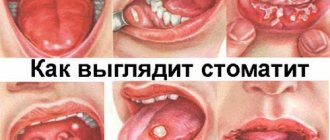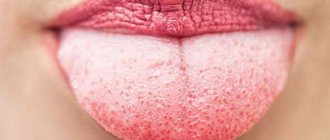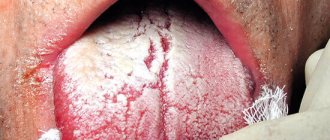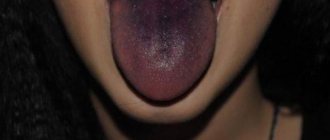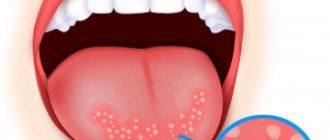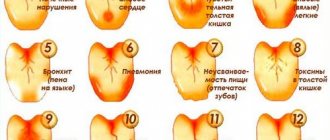What you need to pay attention to first:
- color;
- density;
- location;
- character (consistency: uniform, lumpy, rough or smooth; presence or absence of spots);
- localization;
- ease of cleansing;
- frequency of reappearance.
If you do not complain about the state of your health, but there is still plaque, then these are usually formations that appear in the morning after a night's sleep or in the evening. They are light in color - white or transparent. Through them it is easy to see the surface of the tongue and the papillae on it. It is a thin, non-viscous film. It is evenly distributed over the walls of the oral cavity and can be easily cleaned with a toothbrush or floss.
Diagnostics
After detecting an atypical coating on the tongue, you should immediately consult a doctor, since such a phenomenon may be associated with various abnormalities in the body - both mild and severe.
First, the specialist pays attention to criteria such as:
- the area of the tongue where plaque has formed;
- plaque color;
- relief of the tongue;
- thickness of the plaque layer;
- other features are the presence of spots, plaques, ulcers, trembling of the tongue.
To clarify the diagnosis, measures such as blood, stool and urine tests, and ultrasound of internal organs are prescribed.
Yellow plaque on the palate and a white film in the mouth in the morning: reasons if after brushing
The appearance of plaque in the mouth is caused by abnormalities in the functioning of internal organs and systems. Sometimes this phenomenon is the only manifestation of the pathology, and in some cases it is accompanied by discomfort, pain, and an unpleasant odor. Indicators such as the color, thickness and consistency of plaque in the oral cavity can help a specialist determine the diagnosis.
Reasons for education
Plaque formation in the mouth can be caused by one of the following factors:
- fungal diseases. This may be candidal stomatitis or glossitis. The Candida fungus, which is present in the natural microflora even under normal conditions, is activated in the presence of predisposing factors. The development of candidiasis is facilitated by long-term use of antibiotics, a weakened immune system, and past infectious diseases;
- HIV infection, which inevitably reduces the body's defenses;
- acute viral infections;
- helminthic infestations, in which parasites infect the mucous membrane of the gastrointestinal tract;
- lack of iron, folic acid;
- liver dysfunction, which is often associated with abuse of fatty foods;
- disruption of the gastrointestinal tract and gall bladder;
- poisoning with toxic substances - heavy metals, mercury.
Also, the appearance of plaque in the mouth can be caused by blood diseases, regular stress, which causes the mouth to dry out, the formation of malignant tumors, and the use of certain medications. Another possible and relatively harmless reason is neglect of personal hygiene standards.
Plaque is often the result of eating colored foods or drinking liquids. These include coffee, strong tea, chocolate, beets, and mulberries.
Kinds
Plaque in the mouth, depending on the predisposing factor, has a different color. This sign helps in diagnosing the underlying disease.
White film
If a white coating appears in the oral cavity, in particular in the mouth, this can be explained by several reasons.
Many people wake up to find a white layer covering their tongue.
This phenomenon is absolutely normal. It goes away after brushing your teeth. But, if hygiene procedures do not affect the plaque layer in any way, you can suspect:
- disturbances in the functioning of the stomach, developing gastritis. In this case, the white mass is concentrated in the center of the tongue. In addition, small cracks can be traced in this area;
- oral thrush. Candidiasis occurs when the immune system is weakened, the presence of HIV, and in old age, especially if a person wears removable dentures. 50% of newborns have oral thrush. For more information about the treatment of candidal glossitis, see here;
- tongue diseases – galvanic stomatitis, catarrhal glossitis;
- systemic and hereditary diseases that disrupt the process of keratinization of tongue cells - dermatoses, lichen pilaris, leukoplakia;
- infectious disease of the lungs or respiratory system. In this case, the anterior third of the organ is covered with a white film, and white dots may appear on the tongue.
Relatively safe reasons for the appearance of a white film in the oral cavity are the consumption of food that has coloring properties and insufficient care.
It is important to pay attention to the shade of the resulting coating. Thus, a white film with a gray or yellow tint indicates the presence of viruses or bacteria in the oral cavity.
If the plaque was initially white, then acquired a blue tint, after which it became white again, then there is a suspicion of dysentery or typhoid fever.
A greenish color indicates the development of a fungal infectious process provoked by long-term use of steroids, antibiotics or antidepressants.
Treatment depends on the patient's disease:
- for candidiasis, antifungal drugs Diflucan or Clotrimazole are prescribed orally. In addition, Clotrimazole 1% ointment is prescribed for application to the mucous membranes;
- for diseases of the tongue, antiseptic drugs (Chlorhexidine), anti-inflammatory drugs (Corsadine), and healing agents (vitamin A in solution) are prescribed.
If the appearance of a white film in the patient’s mouth is associated with dysfunction of the internal organs, a comprehensive examination is prescribed and, depending on the results obtained, the course of treatment is determined.
Green film
The formation of a greenish coating on the tongue is associated with the following reasons:
- hormonal changes in the body. Typically, a green coating appears in adolescents during puberty;
- diseases of the gastrointestinal tract;
- HIV infection;
- intoxication;
- abnormalities in liver function.
A greenish mass with a tinge of yellow on the surface of the tongue and mucous membranes indicates:
- infectious intestinal pathologies;
- gallbladder diseases;
- severe lung damage;
- increased bilirubin levels;
- catarrh of the tongue;
- fungus.
If the film has an intense dark green color, then this is due to such severe pathologies as cholera or Crohn's disease.
Treatment is prescribed after determining the exact cause of plaque formation:
- for stagnation of bile, the drugs Lyobil, Allohol are recommended;
- in case of intoxication of the body, adsorbents (Enterosgel) are prescribed;
- for fungal infectious processes, the use of antifungal agents (Decamin, Fluconazole) is indicated.
Simultaneously with taking medications, you need to rinse your mouth with antiseptic solutions Chlorophyllipt, Miramistin. You can also use a solution of potassium permanganate.
Brown color
The formation of a brown coating on the tongue is due to the following factors:
- drinking coffee, black tea and chocolate in large quantities;
- deficiency of vitamin B3 in the body;
- stomatitis;
- exacerbation of chronic inflammation of the duodenum; enterocolitis;
- dehydration of the body;
- advanced candidiasis of the oral mucosa;
- bowel problems (diarrhea, frequent constipation);
- dysbiosis.
A brown coating on the tongue indicates serious illness, so it is necessary to diagnose and treat the identified disease.
Additional techniques that will allow you to get rid of brown plaque are rinsing your mouth with a decoction of chamomile or sage, replenishing vitamin B3 in the body by consuming milk, legumes, and mushrooms.
Yellow film
If plaque in the oral cavity turns yellow, this is due to the following reasons:
- helminthiases;
- severe diseases of the liver (cirrhosis, hepatitis) and biliary tract;
- inflammation of the tongue (glossitis);
- respiratory viral diseases;
- caries;
- bleeding gums and unpleasant odor;
- taking certain medications (in particular, antibacterial agents).
In some cases, the formation of yellow plaque is accompanied by a feeling of bitterness in the mouth.
This combination of symptoms is associated with diseases of the pancreas and liver, and dysfunction of the gastrointestinal tract.
Treatment is carried out as follows:
- in case of disturbances in the outflow of bile, it is recommended to take choleretic drugs (Nicodin, Allochol, Cholenzym);
- for intestinal motility disorders, Metoclopramide and Cerucal are prescribed;
- in case of exacerbation of chronic cholecystitis, the patient is prescribed antibacterial drugs from the groups of fluoroquinolones, tetracyclines, microlides;
- To restore liver cells, you need to take Essliver, Hepatosan, Essentiale.
The specialist determines the required dosage in each specific case.
White spots on tongue
White dots on the tongue of an adult and a child are associated with the following reasons:
- acute and chronic gastritis;
- acute pancreatitis;
- oral candidiasis;
- ARVI and acute respiratory infections;
- scarlet fever;
- measles;
- dysentery;
- lichen planus in the mouth;
- syphilis;
- AIDS and HIV.
Listed above are ways to combat the diseases mentioned in this list.
Black plaque
Black color on the tongue and mucous membranes of the oral cavity is a phenomenon that is associated with the following reasons:
- violation of the acid-base balance in the body. A similar condition occurs when eating a small amount of plant foods and the predominance of foods high in cholesterol in the diet;
- chromogenic fungal infection. In this case, not only the tongue and oral mucous membranes blacken, but also the tooth enamel;
- chronic intoxication of the body;
- chronic alcoholism.
If a black-yellow tint appears, then inflammatory processes in the gastric mucosa, as well as pathologies of the liver and gallbladder, are suspected.
If you find a black coating on your tongue, you need to see a doctor for a diagnosis.
In case of disturbances in the acid-base balance in the body, the patient is prescribed a diet, as well as taking complexes with vitamins and minerals - Calcium Magnesium Chelate, Coral Calcium. In case of chronic intoxication, a special diet, adsorbents, laxatives and diuretics are also prescribed.
Diagnostics
After detecting an atypical coating on the tongue, you should immediately consult a doctor, since such a phenomenon may be associated with various abnormalities in the body - both mild and severe.
First, the specialist pays attention to criteria such as:
- the area of the tongue where plaque has formed;
- plaque color;
- relief of the tongue;
- thickness of the plaque layer;
- other features are the presence of spots, plaques, ulcers, trembling of the tongue.
To clarify the diagnosis, measures such as blood, stool and urine tests, and ultrasound of internal organs are prescribed.
This video will tell you in detail about the causes of plaque on the tongue in adults.
Conclusion
- Plaque in the mouth can have different colors, consistency, and thickness.
- Specialists get an initial idea of the presence of a certain deviation precisely from these signs.
- The appearance of colored plaque can be associated both with relatively harmless reasons (aphthous stomatitis, caries) and with severe pathologies, so such a sign should never be ignored.
Source: https://ZubZdorov.online/bolezni/simptomy/nalet-vo-rtu
Green, brown, gray or bluish
Such indicators indicate the advanced course of various diseases, but for people who are attentive to their hygiene and health in general, these cases are rare.
A green coating indicates the occurrence of putrefactive processes in the mouth. Their development is caused by active resistance of immune cells to harmful microorganisms and viruses. Therefore, the root cause should be sought in the presence of such. People who have suffered from acute respiratory viral infections and acute respiratory infections are at risk.
Insufficient teeth cleaning can also have such consequences. If a person does not use floss for hard-to-reach places, food particles may remain there for a long time, which gradually decompose, which leads to an increase in plaque and mucus in the mouth, as well as an unpleasant odor.
Another provoking factor is caries - a pathological process that occurs in the hard tissues of the tooth and is of a bacterial nature.
Brown or dark brown plaque indicates problems with the respiratory tract, including the lungs. People who are addicted to alcohol and smoking also have such layers.
Gray plaque is an integral accompaniment of dehydration.
The blue color of the tongue indicates a malfunction of the cardiovascular system; this may cause the white coating to appear bluish or bluish.
White plaque in the mouth after brushing teeth
White plaque in the mouth is one of the signs of candidal stomatitis. This pathology is caused by the Candida fungus and most often affects young children. In addition to deposits, redness appears on the oral mucosa, which causes severe discomfort.
For what reasons does it appear?
White plaque in the mouth in adults occurs for the following reasons:
- development of endocrine pathologies;
- metabolic disorder;
- taking medications (antibiotics, hormonal drugs);
- vitamin deficiency;
- chronic infections of the nasopharynx and oral cavity;
- hepatitis (in particular hepatitis C).
Sometimes this symptom signals the development of cancer processes. In 10% of cases, intestinal cancer manifests itself this way.
What does it mean to have a whitish coating in your mouth in the morning?
In 80% of cases, this symptom is provoked by dry mucous membranes. This happens when a person sleeps with his mouth open - the appearance of deposits is due to a violation of natural hydration.
Another possible reason is impaired saliva production.
In women, this symptom occurs against the background of hormonal changes. Expectant mothers, as well as women in menopause, are at risk.
Appearance of yellowish deposits
A yellow coating appears in smokers, as well as in fans of black tea and coffee. If it is present in small quantities, there is no need to worry. If the deposits are poorly removed and are accompanied by additional symptoms, we may be talking about liver damage.
Possible reasons for the appearance of yellow deposits:
- gallstones;
- acute pancreatitis;
- cholecystitis;
- hepatitis.
A noticeable greenish tint may indicate stagnation of bile.
Plaque localization
Having penetrated the mucous membrane, candida gradually penetrates deep into the epithelium. They secrete special enzymes that can completely destroy cellular structures.
White plaque in the mouth of an adult appears in several areas:
- sky;
- language;
- inner cheeks;
- lips.
Main manifestations
White plaque on the palate of an adult is accompanied by the following symptoms:
- feeling of itching and burning in the mouth;
- the appearance of small ulcers on the mucous membrane;
- hypersensitivity to temperature stimuli;
- feeling of a lump in the throat;
- hypersensitivity to mechanical irritation.
Mouth ulcers are bright pink or red in color. If the wounds become infected, profuse purulent discharge appears.
Primary symptoms
One of the first symptoms of candidal stomatitis is the appearance of dry mouth and white plaque. Deposits appear in the form of ragged or neat small spots.
This symptom is accompanied by severe discomfort, which is expressed in burning and itching of the affected areas.
As the disease progresses, a white coating appears on the inside of the cheeks. Next, the gums and tonsils are affected.
At the initial stage of the pathology, plaque can be easily removed with a cotton swab. Beneath it, painful red lesions are found.
Secondary manifestations
Additional signs include:
- increased sensitivity of the mucous membrane. Eating salty, spicy and sour foods causes pain;
- decreased sense of taste;
- the appearance of a specific metallic taste;
- bleeding ulcers;
- the appearance of mycotic lesions (the skin in the corners of the mouth becomes red, then becomes covered with microscopic cracks. Then a white coating appears in the corners of the lips);
- the occurrence of pain when swallowing saliva;
- an increase in general temperature (this is due to the body’s response to the pathogenic activity of fungi);
- unmotivated weakness, drowsiness;
- the appearance of bad breath;
- slowing down the rate of speech;
- enlargement of taste buds on the tongue.
The “spotty” coating on the sky gradually merges into a continuous white film. Its structure becomes denser and it becomes more difficult to remove.
Establishing a diagnosis
If a plaque is detected on the palate of an adult’s mouth, the doctor undertakes:
- Listen to the patient's complaints.
- Collect anamnesis.
- Inspect the mucous membrane and skin.
- Make a microscopy of a scraping from the oral cavity.
Additionally, the patient may be referred for consultation:
- to a dermatologist - in order to identify fungal infections of other systems and organs;
- endocrinologist - to detect endocrine pathologies;
- an allergist - in order to determine the body’s sensitization to the materials from which dentures are made.
After clarification of the diagnosis, treatment is prescribed.
Features of therapy
Treatment involves the use of topical drugs and internal medication.
To treat the oral cavity in adults, with very high sensitivity of the mucous membrane, it is allowed to use a diluted Lugol's solution (2 tsp per 200 ml of warm water from a kettle).
You can also lubricate the oral cavity with baking soda diluted in water (1/2 tsp per 150 ml of warm boiled water). The procedure should be carried out 2-3 times a day.
Drug therapy involves the use of antifungal and painkillers. Antihistamines are additionally used as prescribed by an allergist.
Use of antifungal agents
The main antifungal drugs are presented in the table:
The table shows the most effective analgesics. They are prescribed only according to indications.
A possible complication is invasive candidiasis, which is a lesion of the mucocutaneous tissue. Sometimes internal organs are involved in the pathological process.
Symptoms of invasive candidiasis:
- skin damage;
- dysphagia (swallowing disorder);
- feverish condition.
In the most severe cases, a shock reaction develops.
Preventive recommendations
Prevention of relapse of candidal stomatitis looks like this:
- strengthening the immune system;
- sanitation of the oral cavity;
- maintaining careful oral hygiene;
- timely detection of candidiasis localized in other places;
- correct use of antibiotics, cytostatics, glucocorticoids;
- timely sanitation of foci of chronic infection.
Conclusion
Persons suffering from immunodeficiency pathologies and endocrinopathies are required to undergo clinical observation and scrupulously follow all doctor’s recommendations.
Category Hygiene Published by Mister stomatolog
Source: https://www.kosmetik-dent.ru/belyj-nalet-v-polosti-rta-posle-chistki-zubov/
How to get rid of plaque on the tongue: effective ways
When getting rid of plaque on the walls of the oral cavity, remember a simple rule: if you get rid of the cause of its occurrence, the plaque disappears. This is true in cases where deposits are pathological in nature. But if you want to reduce the amount or completely get rid of the natural plaque that occurs in the morning, then we are ready to share 10 effective tips:
We invite you to familiarize yourself with Prevention of diseases of hard dental tissues - caries and non-carious lesions
Causes of plaque
Experienced therapists can make a primary history just by looking at the patient's tongue. The way the oral cavity looks is one of the most accurate indicators of the health of the body as a whole.
Normally, a person's tongue has a light pink tint, but a small amount of plaque is acceptable. It should be light, loose, and the receptors should be visible through it. Why is this not a deviation?
A completely clean surface is rare and indicates proper self-care. Experts consider it normal to have a thin layer of plaque on the tongue, gums and teeth.
White film in the mouth of an adult
> Dental treatment
28.02.2020
The appearance of plaque in the mouth is caused by abnormalities in the functioning of internal organs and systems. Sometimes this phenomenon is the only manifestation of the pathology, and in some cases it is accompanied by discomfort, pain, and an unpleasant odor. Indicators such as the color, thickness and consistency of plaque in the oral cavity can help a specialist determine the diagnosis.
Brown color
The formation of a brown coating on the tongue is due to the following factors:
Method number 6. silver is the best antiseptic
Another mechanical cleaning method is to “scrape” the plaque using a teaspoon. Silver is best suited, since the metal has well-known healing and antiseptic properties. This type of brushing kills bacteria and removes the white film from the tongue. But with such cleaning, peculiar difficulties arise: when trying to remove plaque from the root of the tongue, a gag reflex occurs, and also, if the plaque is dense, it cannot always be removed without first softening it.
We suggest that you familiarize yourself with The sky is yellow and the throat hurts - Why the soft upper palate in the mouth turned yellow: causes and symptoms of diseases - Medicine in photographs
Remember! If the procedure causes you pain, you should stop it immediately and find another way to get rid of the symptom.
White film on the mucous membrane in the mouth
The appearance of plaque in the mouth is caused by abnormalities in the functioning of internal organs and systems.
Sometimes this phenomenon is the only manifestation of the pathology, and in some cases it is accompanied by discomfort, pain, and an unpleasant odor. Indicators such as the color, thickness and consistency of plaque in the oral cavity can help a specialist determine the diagnosis. The appearance of plaque in the mouth is caused by abnormalities in the functioning of internal organs and systems.
Indicators such as the color, thickness and consistency of plaque in the oral cavity can help a specialist determine the diagnosis.
White plaque on the teeth near the gums is a consequence of poor and irregular oral hygiene.
It consists of microorganisms and their metabolic products, saliva minerals, and organic residues.
In small quantities, white plaque on the teeth near the gums protects the enamel, but as it accumulates, it hardens and turns into tartar, which cannot be removed at home.
The only and effective method for removing plaque near the gums is regular and thorough oral hygiene.
Teeth should be brushed at least 2 times a day, and in between, the use of mouth rinses, dental floss, and irrigators is encouraged.
If the patient’s mouth is healthy, it means that the organs and systems of his body are working correctly. After all, the oral cavity and tongue are an indicator of the general condition.
The mucous membrane is affected when a particular disease progresses. Diseases can be infectious, chronic, acute, specific. White plaque on the palate of an adult is not as common as in children.
It often indicates the presence of chronic illnesses.
The sky performs a very important function. The fornix separates the nasopharynx from the oral cavity. According to the structure, there is a soft and hard part. This organ prevents food from entering the nasopharynx.
Its receptors are connected to the larynx. They participate in articulation, influence the pitch of sounds and timbre of the voice. Mucosal defects interfere with these functions, so they should be eliminated.
In addition, the patient experiences discomfort and pain.
We suggest you read: Why do lips dry out at night?
Reasons for education
Plaque formation in the mouth can be caused by one of the following factors:
- fungal diseases. This may be candidal stomatitis or glossitis. The Candida fungus, which is present in the natural microflora even under normal conditions, is activated in the presence of predisposing factors. The development of candidiasis is facilitated by long-term use of antibiotics, a weakened immune system, and past infectious diseases;
- HIV infection, which inevitably reduces the body's defenses;
- acute viral infections;
- helminthic infestations, in which parasites infect the mucous membrane of the gastrointestinal tract;
- lack of iron, folic acid;
- liver dysfunction, which is often associated with abuse of fatty foods;
- disruption of the gastrointestinal tract and gall bladder;
- poisoning with toxic substances - heavy metals, mercury.
Also, the appearance of plaque in the mouth can be caused by blood diseases, regular stress, which causes the mouth to dry out, the formation of malignant tumors, and the use of certain medications. Another possible and relatively harmless reason is neglect of personal hygiene standards.
Plaque is often the result of eating colored foods or drinking liquids. These include coffee, strong tea, chocolate, beets, and mulberries.
Plaque in the mouth, depending on the predisposing factor, has a different color. This sign helps in diagnosing the underlying disease.
White film
If a white coating appears in the oral cavity, in particular in the mouth, this can be explained by several reasons.
This phenomenon is absolutely normal. It goes away after brushing your teeth. But, if hygiene procedures do not affect the plaque layer in any way, you can suspect:
- disturbances in the functioning of the stomach, developing gastritis. In this case, the white mass is concentrated in the center of the tongue. In addition, small cracks can be traced in this area;
- oral thrush. Candidiasis occurs when the immune system is weakened, the presence of HIV, and in old age, especially if a person wears removable dentures. 50% of newborns have oral thrush. For more information about the treatment of candidal glossitis, see here;
- tongue diseases – galvanic stomatitis, catarrhal glossitis;
- systemic and hereditary diseases that disrupt the process of keratinization of tongue cells - dermatoses, lichen pilaris, leukoplakia;
- infectious disease of the lungs or respiratory system. In this case, the anterior third of the organ is covered with a white film, and white dots may appear on the tongue.
Relatively safe reasons for the appearance of a white film in the oral cavity are the consumption of food that has coloring properties and insufficient care.
It is important to pay attention to the shade of the resulting coating. Thus, a white film with a gray or yellow tint indicates the presence of viruses or bacteria in the oral cavity. If the plaque was initially white, then acquired a blue tint, after which it became white again, then there is a suspicion of dysentery or typhoid fever.
Treatment depends on the patient's disease:
- for candidiasis, antifungal drugs Diflucan or Clotrimazole are prescribed orally. In addition, Clotrimazole 1% ointment is prescribed for application to the mucous membranes;
- for diseases of the tongue, antiseptic drugs (Chlorhexidine), anti-inflammatory drugs (Corsadine), and healing agents (vitamin A in solution) are prescribed.
If the appearance of a white film in the patient’s mouth is associated with dysfunction of the internal organs, a comprehensive examination is prescribed and, depending on the results obtained, the course of treatment is determined.
Green film
Source: https://imdent.ru/belaya-plenka-slizistoy/
You should consult a doctor if plaque:
- changed color from light gray or white to yellow, greenish, brown or even black;
- became denser and led to the appearance of the “coated tongue” symptom.
The reason for the visit may also be other changes, such as the appearance of white particles in the saliva. If this secretion has become cloudy, then there is a high probability of a fungal disease - candidiasis. Thus, deposits on the walls of the oral cavity consist of pathogens and leukocytes on which they feed. In this case, it is necessary to consult with a medical specialist as quickly as possible so that he can prescribe treatment.
